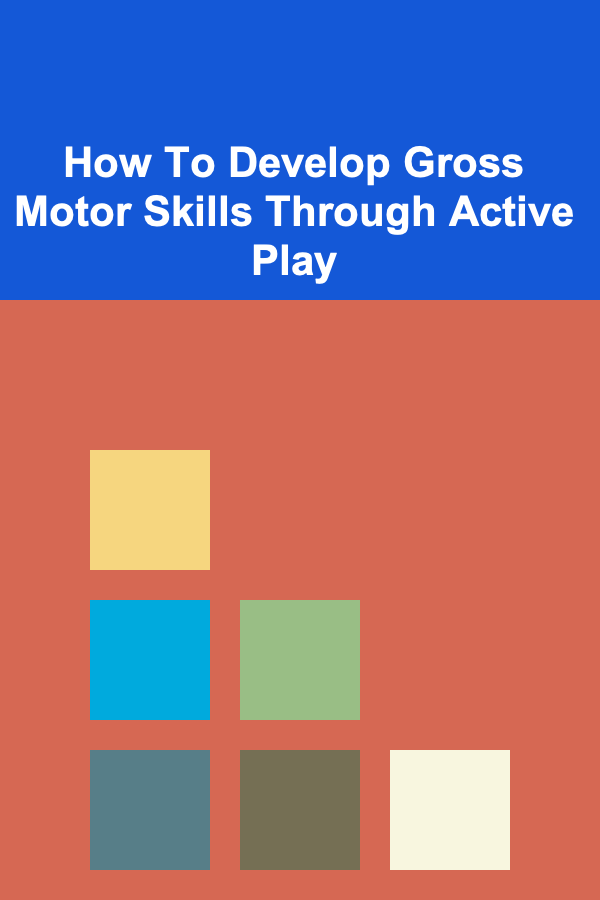
How To Develop Gross Motor Skills Through Active Play
ebook include PDF & Audio bundle (Micro Guide)
$12.99$11.99
Limited Time Offer! Order within the next:

Gross motor skills are the abilities required to control the large muscles of the body. These skills are essential for everyday activities such as walking, running, jumping, balancing, and throwing. They play a critical role in a child's overall development and lay the foundation for physical activity, coordination, and cognitive growth. One of the most effective ways to develop these skills is through active play. In this article, we will explore how active play can foster the development of gross motor skills, the types of activities that promote these skills, and the ways parents and caregivers can encourage children to engage in beneficial physical activities.
Understanding Gross Motor Skills
Before we dive into how active play enhances gross motor skills, it is important to understand what these skills entail. Gross motor skills involve the use of large muscles to perform fundamental movements. These movements are typically coordinated across multiple joints and require strength, stability, and endurance. They allow individuals to perform tasks such as:
- Walking and Running: Fundamental to most daily activities.
- Jumping: Involves strength and coordination.
- Climbing: Builds upper and lower body strength.
- Throwing and Catching: Involves hand-eye coordination and body control.
- Balancing: Critical for stability and coordination.
- Kicking: Strengthens the legs and coordination.
The development of these skills typically begins in infancy and continues throughout childhood. Children gradually learn to control and refine these skills as they grow and engage in different types of physical activities.
The Role of Active Play in Developing Gross Motor Skills
Active play is a broad term that refers to physical activities that involve movement, interaction, and fun. It is through active play that children develop their physical, emotional, and social skills. Active play promotes gross motor development in several ways:
- Building Strength and Coordination: Gross motor activities engage the large muscles of the body, helping to build strength and improve coordination. Whether it's running, climbing, or swimming, these activities enhance muscle control, posture, and balance.
- Enhancing Flexibility and Agility: Through active play, children develop flexibility, which allows them to perform a wide range of movements. Activities that require quick changes in direction, such as chasing games or obstacle courses, improve agility and help refine motor control.
- Encouraging Spatial Awareness: Gross motor play requires children to navigate space, judge distances, and be aware of their surroundings. This enhances their spatial awareness and ability to move fluidly through different environments.
- Promoting Cognitive Development: As children engage in active play, they use their bodies to solve problems and make decisions. Whether they are figuring out how to climb a ladder or catch a ball, children are developing cognitive skills such as planning, memory, and concentration.
- Supporting Emotional Well-being: Active play also provides emotional benefits by allowing children to explore their physical limits, take risks, and express themselves. It helps build confidence, perseverance, and self-esteem as children master new skills and overcome challenges.
Types of Active Play that Develop Gross Motor Skills
There are many forms of active play that can help children develop their gross motor skills. These activities should be fun, engaging, and age-appropriate to maximize their effectiveness. Below are several examples of active play activities that can foster the development of gross motor skills:
1. Running and Chasing Games
Running is one of the most basic gross motor skills that children develop. Activities like tag, relay races, and chasing games are excellent for building cardiovascular health, leg strength, and coordination. These activities require children to move quickly and change direction, which helps them refine their motor control.
- Tag: A simple game of tag encourages children to sprint, dodge, and maneuver, which improves their speed, agility, and balance.
- Relay Races: Relay races involve running in a team, passing a baton, and strategizing the best route. This activity builds teamwork, coordination, and endurance.
2. Jumping and Hopping
Jumping is a key aspect of gross motor development, requiring strength and balance. Children can practice jumping by engaging in games that involve jumping over objects, hopping on one foot, or jumping in place. These activities help build leg strength, coordination, and balance.
- Jump Rope: Jumping rope enhances coordination and rhythm. It challenges children to time their jumps while keeping a steady rhythm.
- Hopscotch: This classic game helps children practice hopping and balancing on one foot, improving coordination and spatial awareness.
3. Climbing and Crawling
Climbing and crawling are excellent activities for developing strength and motor skills. These movements engage both the upper and lower body and promote coordination, balance, and flexibility.
- Climbing Structures: Playgrounds with climbing walls, jungle gyms, and monkey bars provide opportunities for children to engage their arms, legs, and core muscles. Climbing challenges children to assess their body's limits and improve their spatial awareness.
- Crawling Games: Crawling helps to develop muscle strength in the arms and legs and promotes coordination between the body's upper and lower parts.
4. Throwing and Catching
Throwing and catching involve hand-eye coordination and fine-tuning motor skills. Playing catch with a ball, tossing beanbags, or throwing objects through hoops helps children learn how to judge distances and coordinate their movements.
- Ball Games: Catching, tossing, or throwing a ball improves hand-eye coordination, grip strength, and upper body control. Simple games like catch or soccer are ideal for children to practice these skills.
- Beanbag Toss: Tossing beanbags into containers or targets helps children improve their aim and coordination.
5. Dancing and Moving to Music
Dancing is an excellent way for children to develop gross motor skills while also expressing creativity. It promotes balance, flexibility, coordination, and rhythm. Dancing to music encourages children to move their bodies in different ways, improving spatial awareness and control.
- Dance Routines: Teaching children simple dance moves or allowing them to freestyle to music helps them improve their rhythm and body coordination.
- Freeze Dance: In this game, children dance when the music is playing and freeze when it stops. It enhances listening skills, coordination, and balance.
6. Riding Bicycles and Scooters
Riding a bike or scooter involves coordination between the legs and hands, helping children develop motor control, balance, and strength. These activities also improve stamina and endurance.
- Bicycle Riding: Cycling helps children develop coordination, balance, and leg strength. It also provides an opportunity for children to explore their environment and engage in outdoor play.
- Scooter Riding: Riding a scooter helps to build leg strength and coordination, as well as enhance balance and fine motor skills.
7. Obstacle Courses
Obstacle courses are a fun and challenging way to combine various gross motor activities into one game. By navigating through obstacles, children build strength, agility, and coordination. These courses often involve climbing, jumping, crawling, and balancing---all essential elements for gross motor skill development.
- Backyard Obstacle Course: Set up a series of challenges using everyday items like cones, cushions, ropes, and chairs. Children will improve their ability to assess distances, navigate obstacles, and improve balance.
- Gymnastics Courses: Gyms often offer obstacle-style challenges that involve jumping, balancing, and stretching. These are great for building flexibility and body control.
Encouraging Active Play: Tips for Parents and Caregivers
Parents and caregivers play an essential role in encouraging children to engage in active play. Here are some tips for fostering a love of physical activity and ensuring children develop strong gross motor skills:
1. Create an Active Environment
Create an environment that encourages physical activity. This includes providing access to playgrounds, open spaces, and safe outdoor areas where children can run, jump, and play freely. Ensure that the environment is safe and age-appropriate, with soft surfaces and equipment designed for children.
2. Be a Role Model
Children are more likely to engage in active play when they see adults participating in physical activities. Be a role model by taking part in active play, whether it's playing catch, going on bike rides, or dancing with them. Your enthusiasm will encourage children to stay active and enjoy physical activities.
3. Incorporate Active Play into Daily Routine
Incorporate active play into the daily routine by encouraging movement during regular activities. For example, take the stairs instead of the elevator, have dance breaks, or go for walks after meals. Finding small ways to stay active throughout the day helps children develop the habit of physical movement.
4. Make It Fun
Above all, make active play enjoyable. Children are more likely to participate in activities they enjoy, so try to make physical activities as fun and engaging as possible. Use games, music, and creativity to make movement exciting.
5. Limit Screen Time
Too much screen time can contribute to a sedentary lifestyle. Encourage children to engage in physical activities by limiting screen time and providing opportunities for active play. Set aside specific times for outdoor play and active movement, and make sure children have access to toys, games, and activities that promote physical exercise.
Conclusion
Gross motor skills are essential for children's development, and active play is one of the best ways to develop them. Through activities like running, jumping, climbing, and throwing, children enhance their strength, coordination, balance, and spatial awareness. By creating opportunities for active play, encouraging regular movement, and being a role model, parents and caregivers can support children in developing their gross motor skills and fostering a lifelong love of physical activity. With the right encouragement and environment, children can grow stronger, healthier, and more confident in their abilities.

How to Budget Effectively with a Variable Income
Read More
How to Make Smart Purchases During Holiday Sales and Discounts
Read More
How to Snack Smart for Weight Loss
Read More
How to Integrate into Local Communities Abroad
Read More
Understanding Artificial Intelligence in Diagnostics
Read More
How to Restore Old Coins Found Metal Detecting
Read MoreOther Products

How to Budget Effectively with a Variable Income
Read More
How to Make Smart Purchases During Holiday Sales and Discounts
Read More
How to Snack Smart for Weight Loss
Read More
How to Integrate into Local Communities Abroad
Read More
Understanding Artificial Intelligence in Diagnostics
Read More